Voci incise sulla pietra
Ex Ospedale Psichiatrico di Volterra – Febbraio 2017
(testo di Sonia Caravelli – foto di Demetrio Massimo Opinato)
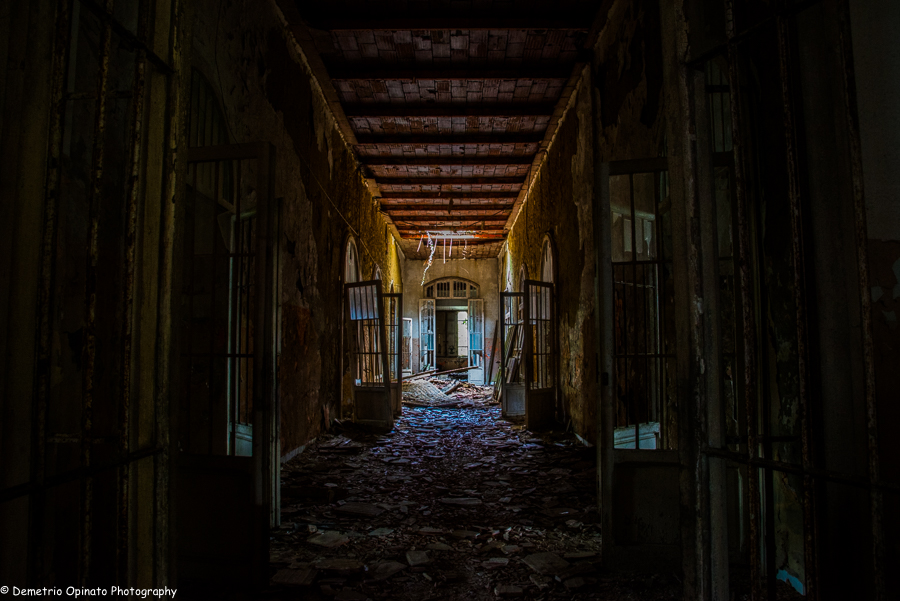
Esiste un brano semisconosciuto di un eccentrico musicista belga che ad un certo punto recita:”since the day we found you/you have been our friend/and your voice still echoes in the hallways of this house/but now/it’s the end“. La “voce” che “riecheggia nei corridoi” mi ha sempre provocato qualche brivido, lo ammetto, ma adoro questa canzone. Quel pomeriggio, in macchina, mi vagava in testa senza un apparente motivo, mentre ci dirigevamo verso Volterra, un piccolo comune che conta poco più di 10.000 anime nella provincia di Pisa, in Toscana. Se non avete mai avuto il piacere di visitarlo, sappiate che il centro storico è un invito che non si può disattendere, protagonista di visioni oniriche di registi famosi, balcone orgoglioso delle sue origini etrusche e dello straordinario artigianato del luogo. Questa volta però non era lui il nostro obiettivo bensì quello che in un passato non troppo remoto era stato un fiore all’occhiello della cittadina, amplificandone il nome in tutta Italia per l’imponenza di un ambizioso progetto divenuto ben presto materia.
L’ex ospedale psichiatrico di Volterra nasce da un ente morale, un ospizio di mendicità per la povera gente, il 5 giugno del 1884. Si dice che fu Aurelio Caioli, divenuto presidente della congregazione di carità, il primo a gettare i semi di quella realtà futura, stipulando convenzioni con la provincia di Pisa prima e con quelle limitrofe in seguito. Egli stesso curò, goccia a goccia, il trasferimento dei degenti dalle strutture, sparse per la regione, che li avevano ospitati fino a quel momento. Anno dopo anno l’area dell’ospedale si espandeva, con i suoi padiglioni vecchi e nuovi, accumulando terreno nella zona di Borgo San Lazzero. Si stima che intorno al 1939, l’intera struttura contasse quasi 5000 pazienti.
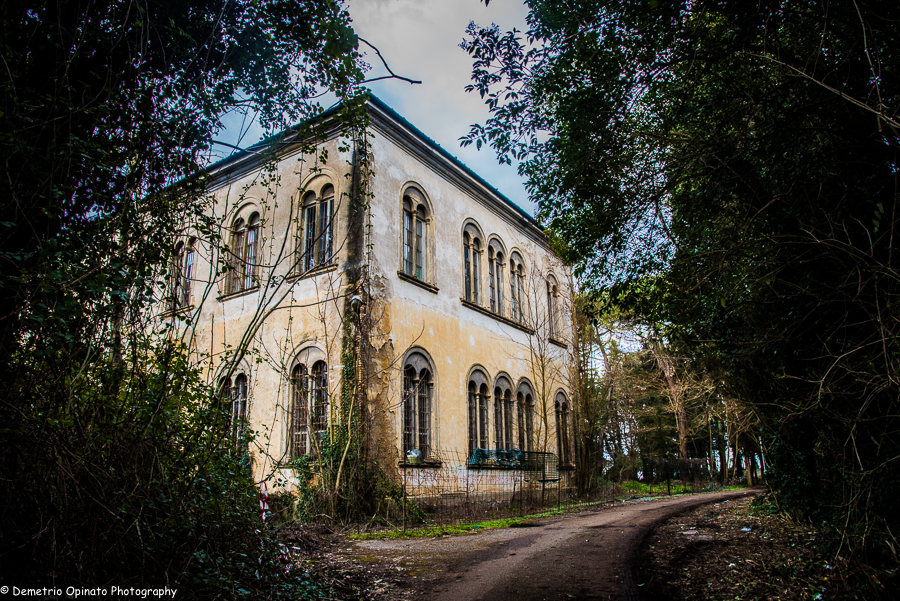
Sotto la conduzione di Luigi Scabia, nominato direttore dell’asilo dementi, il progetto conobbe una fase di fioritura fino a dare vita ad una vera e propria cittadella. Scabia non voleva degli internati, ma dei pazienti da curare e reinserire in società. Ancor più dell’obiettivo, il verbo “curare” dovrebbe richiamare potentemente l’attenzione del lettore. Per i tempi di cui si racconta, voler curare la follia era folle. Bene, a Volterra ci si provò. Lungi dal divenire idillio, i pur sempre rigidi protocolli dell’ospedale erano però scanditi dalla vera terapia: la dignità, più genuinamente chiamata “lavoro”.
Per quanto criticata per i suoi possibili risvolti utilitaristici, l’ergoterapia di Scabia abbattè la geometria dei luoghi di cura, trasformando un ospedale in un villaggio. Il frenocomio di San Girolamo era autonomo da tutti i punti di vista, era dotato di un acquedotto, di una falegnameria, di un panificio, di una calzoleria, di officine. Nel 1933 venne addirittura istituita una moneta ad uso esclusivo dei ricoverati lavoratori per gli acquisti presso l’Ospedale.
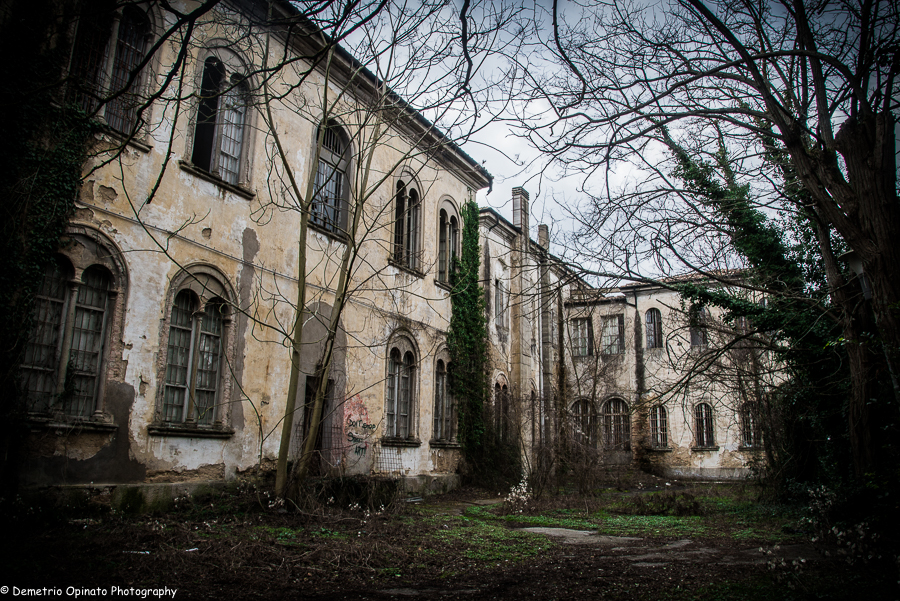
Dopo l’addio a Scabia, pare che i suoi indirizzi siano stati seguiti ancora per un rispettabile margine di tempo ma la stretta stava per arrivare ed il luogo di cui parliamo subì una parabola discendente che le fonti registrano fino al 1963 circa. Il cambiamento era ormai inevitabile e l’aria di trasformazione sociale iniziava a pizzicare i nasi di molti. La deistituzionalizzazione di quegli anni era come un’eco lontana ma stava dirigendosi verso obiettivi opposti: la dismissione.
La nota legge 180, nel 1978, mise fine alla lunga e, nella maggior parte dei casi, estremamente triste storia dei manicomi in Italia. Si iniziò il (complicatissimo) reinserimento dei “malati” nel mondo dei “sani”. Le strutture di Borgo San Lazzero vennero definitivamente abbandonate nei primi anni ’80. Era trascorso circa un secolo.
Ed è qui che ci troviamo, immersi nel sito di una lunga storia, raccontata in poche righe (sintesi imperdonabile quanto necessaria) qui sopra.
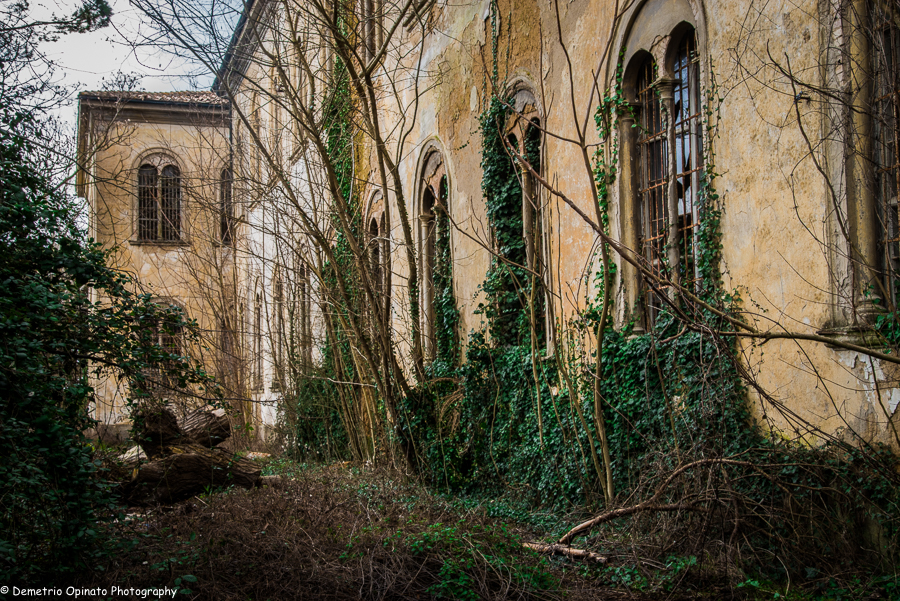
Camminiamo lentamente. C’è una certa aspettativa in relazione a posti del genere, che a volte rimane tale. Noi invece abbiamo materia viva davanti agli occhi e la sensazione è di esserne avvolti. La luce è fantastica. Ok ok, il fotografo me ne starà indirizzando di tutti i colori, forse è meno fantastica quando devi catturare a dovere un’immagine. Di sicuro, però, quel grigio mesto e delicato riusciva a catturare perfettamente i pensieri. Ogni tanto, all’interno dei padiglioni, passando da una stanza all’altra, addirittura ci sorrideva, facendo filtrare attraverso i vetri rotti delle enormi finestre qualche inaspettato raggio di sole.
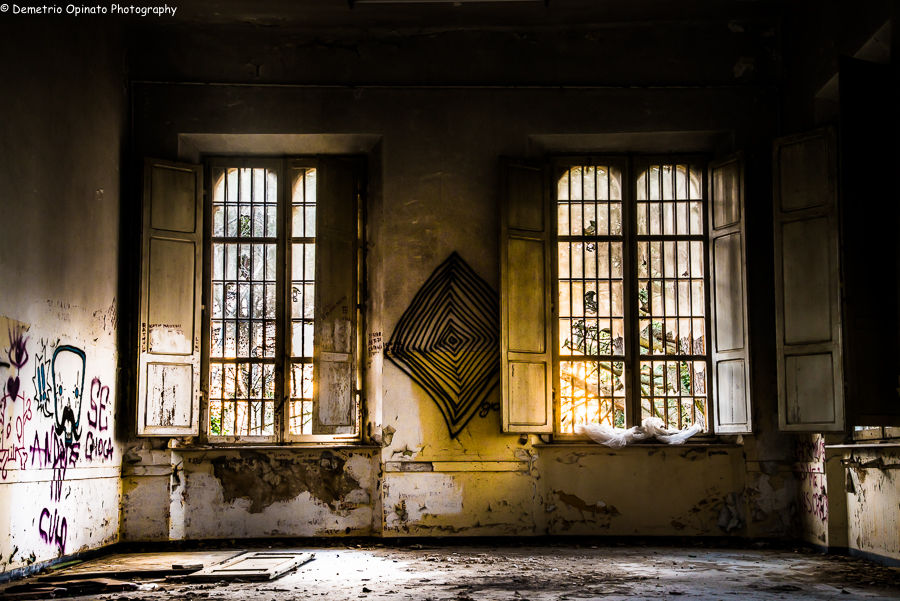
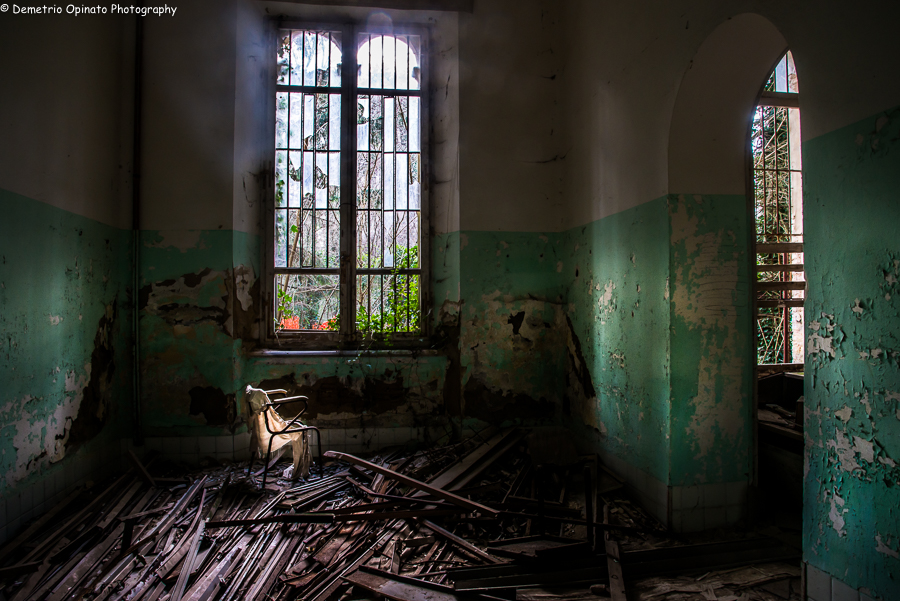
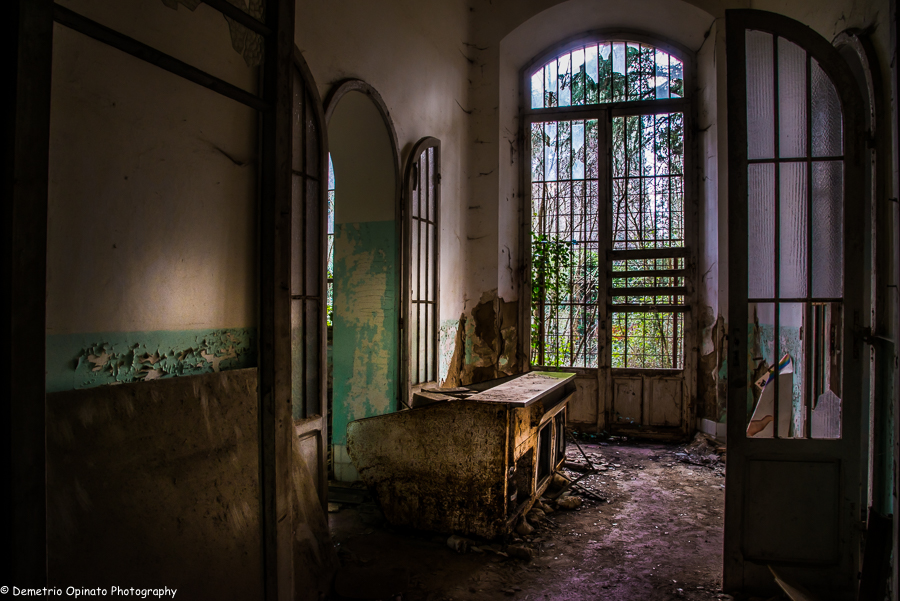
Bisogna avere rispetto del passato e quando si va a fargli visita bisogna parlare a bassa voce. Sono quelle cose strane che si fanno automaticamente e a cui, recuperata un po’ di lucidità, difficilmente si trova una giustificazione adeguata.
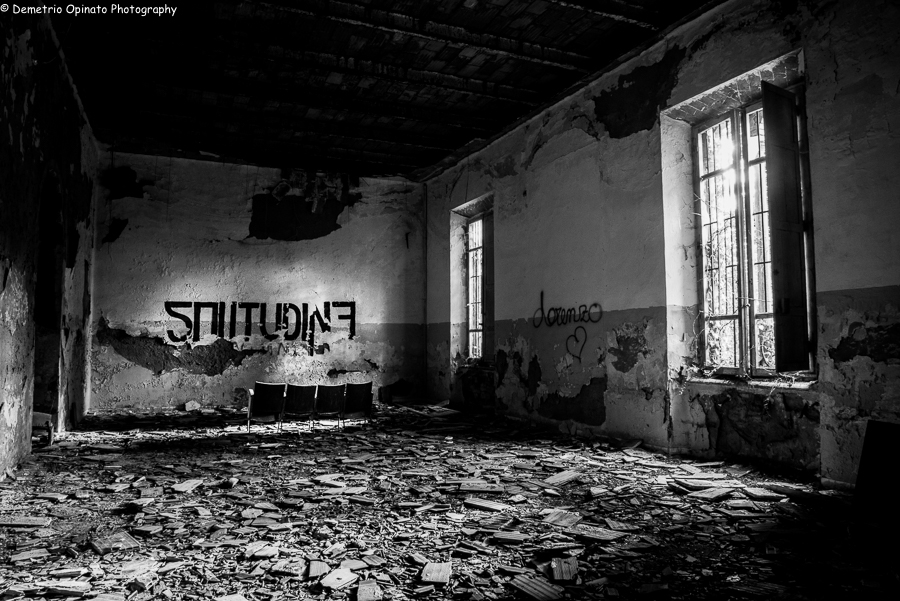
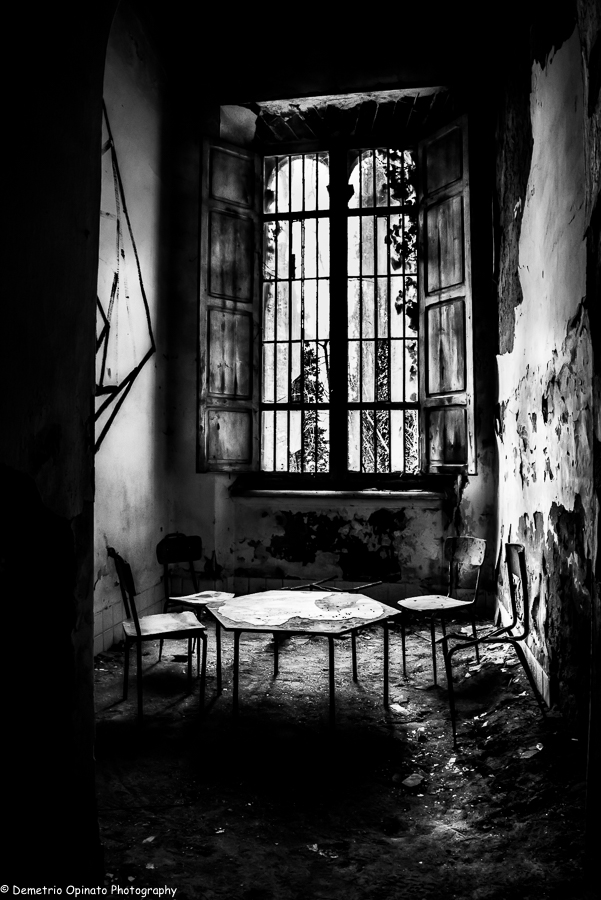
I padiglioni sono disseminati qua e là, all’interno hanno un po’ tutti la stessa struttura: zona giorno al piano terra con quelli che probabilmente erano gli uffici deputati all’accettazione e registrazione dei pazienti, zona notte sopra. I piani superiori sono quasi inaccessibili, come le scale d’altronde. Ci impegniamo a trovare gli oggetti che realmente appartengono a quei luoghi e a separarli dagli “intrusi”: la pavimentazione bianca e nera, ancora visibile seppur raramente, porte affastellate, un lampadario rotto che lascia intravedere due lampadine, probabilmente utilizzate per scandire senza fraintendimenti i ritmi della giornata. Luce chiara per le ore diurne, luce blu per le ore notturne. Sedie a rotelle, forse non indigene. Manichini. Si, non avete letto male, manichini. Quasi tutti senza testa, qualcuno vicino ad una finestra, qualcuno abbandonato su vecchie brande vuote, uno è addirittura appeso a testa in giù. No, non hanno girato un film noir ma i sets sono ovunque. Pare che i grandi media amino dare al grande pubblico le grandi emozioni che si aspetta. Deluderlo sarebbe una grande fregatura.
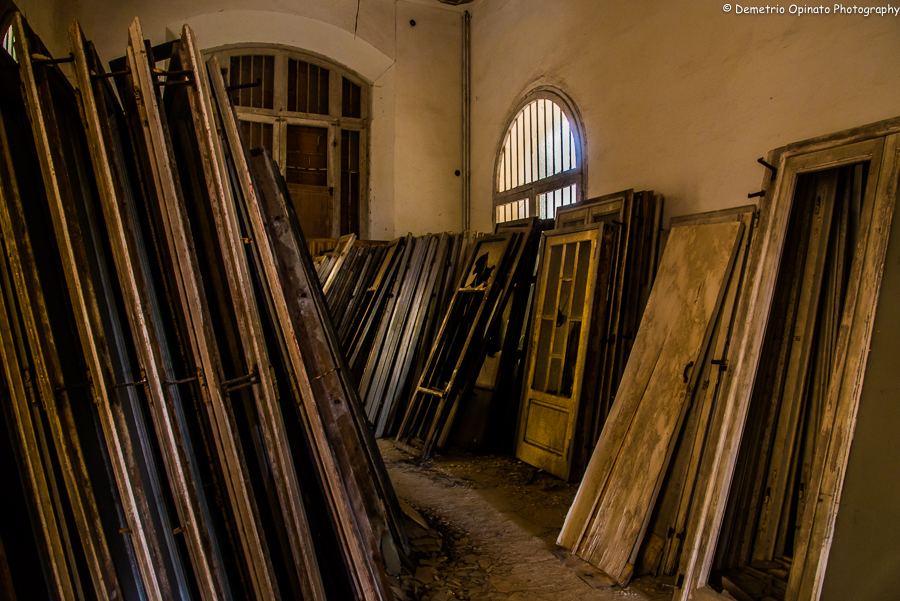
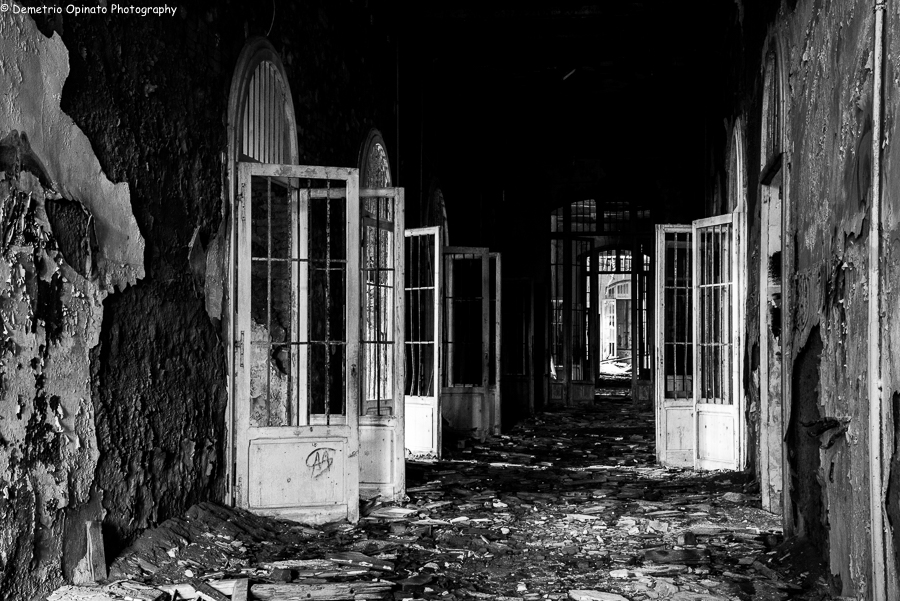
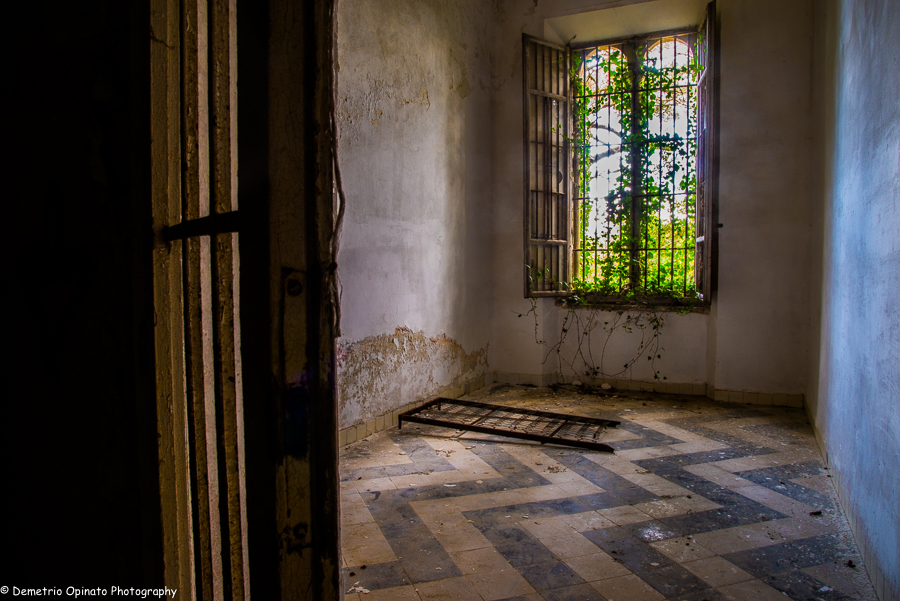
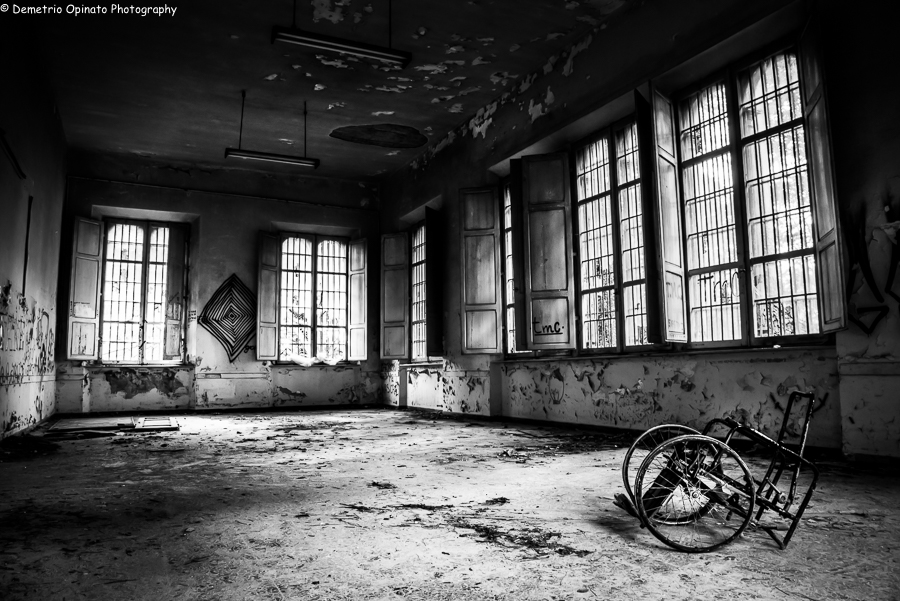
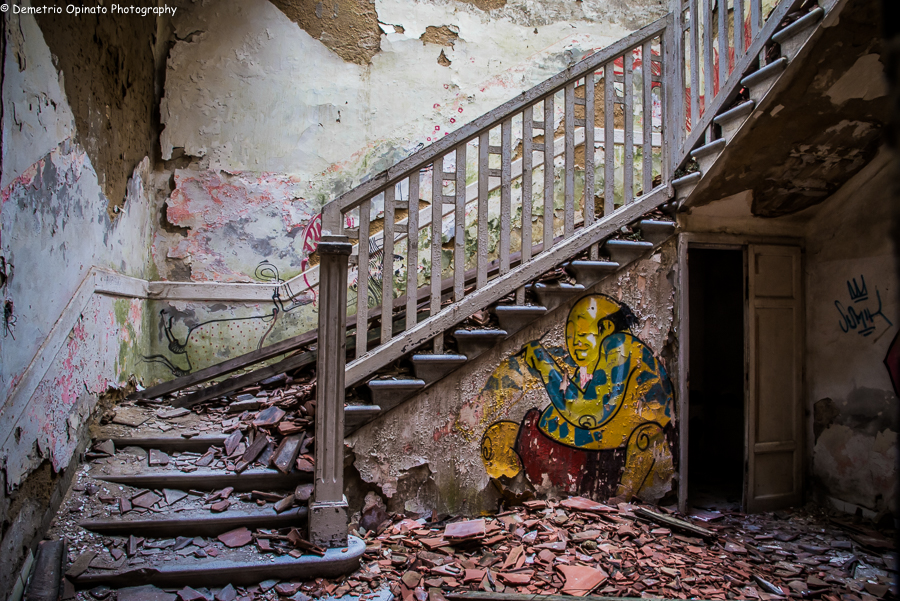
Andiamo avanti. Percorriamo una bellissima scalinata in pietra, letteralmente fagocitata dalla vegetazione.

Gli alberi, le siepi “cresciute”, ogni elemento di madre natura pare avere avuto qui uno sviluppo abnorme. I rami contorti si sono ripresi ogni cosa: tetti, finestre, tavolini in pietra ed altri arredi “parvenza”. Tutto è abbarbicato da un possente abbraccio verde, impertinente quanto simpatico. Mi domando cosa sarebbe questo luogo senza di lui e la risposta mi fa immediatamente abbandonare la domanda.
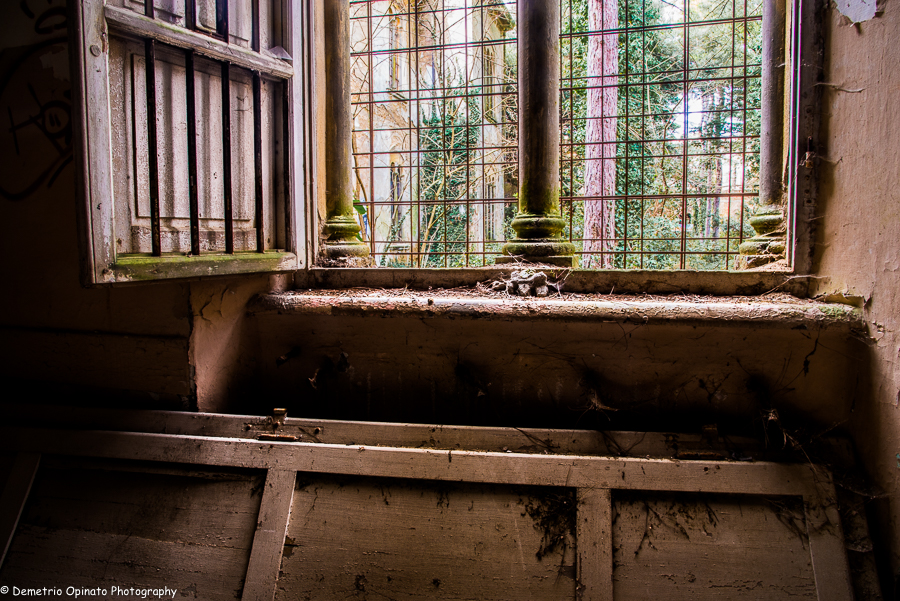
Arriviamo in cima. Sulla destra si erge solitario il padiglione Ferri. Si tratta della sezione giudiziaria, luogo di detenzione per criminali affetti da vizio di mente. Si narra che il direttore Scabia non fosse per nulla contento di questa struttura, postuma rispetto all’originario complesso, poiché contraria alla sua terapia del recupero sociale ed umano. Ma a quanto pare la sua volontà non fu decisiva.
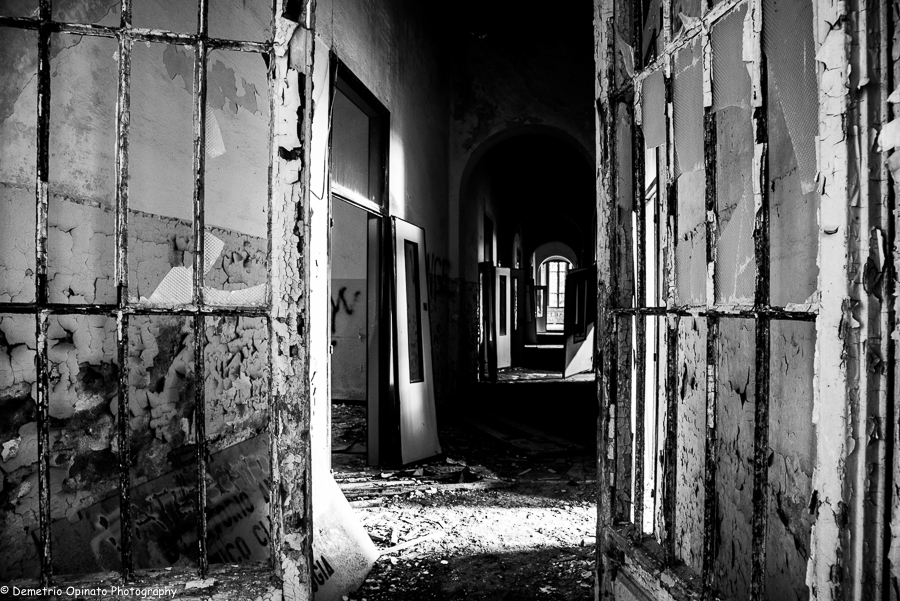
Anche qui l’atmosfera è tiepida, il grigiore dell’edificio è ravvivato dai colori di quella natura indisciplinata che le immagini spiegano più delle parole. All’interno, il pavimento è un mare di detriti, calcinacci e parti di un solaio quasi interamente crollato. Come altrove, il benvenuto è dato da un lunghissimo corridoio su cui si aprono innumerevoli stanze, sovrastate da finestroni che spezzano l’aria con le loro pesanti inferriate. Anche qui centinaia e centinaia di murales di protagonisti di storie moderne che hanno deciso che quelle pareti dovevano essere le loro tele. La scritta PAZZIA urla da un lato. Scontata? Forse. Eppure riesce ad unirsi al coro perfettamente.
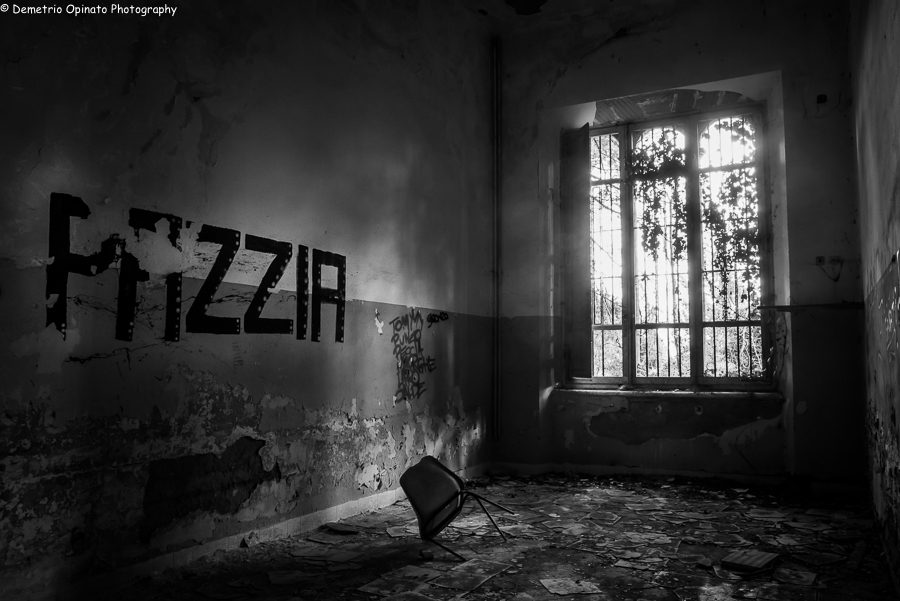
Più in fondo stanzette defilate, in penombra, forse celle più sicure.
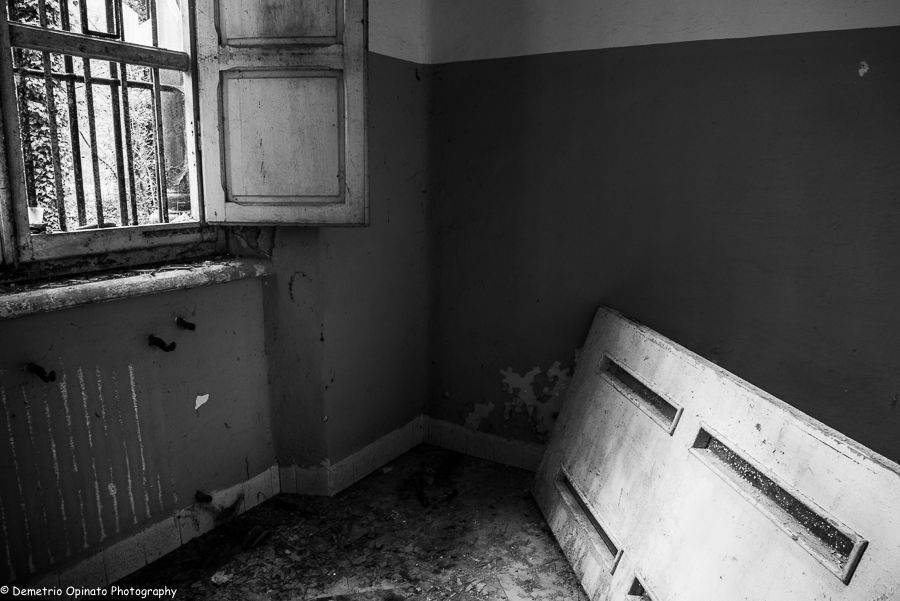
Si sente il bisogno di aria e di luce e non tardiamo ad accontentarlo.
Uscendo continuiamo a guardarci intorno, anche se da quel cortile siamo già passati.
L’edificio ha ovviamente una struttura diversa da quella degli altri, è serrato ed il suo perimetro non si estende al villaggio. Chi vi entrava, d’altronde, doveva scontarci una pena ed anche avendo necessità di cure, era pur sempre un detenuto. Quella era una vera e propria struttura di contenimento. Com’è naturale che sia, ci fermiamo ad osservare quelle mura. Viene spontaneo pensare che abbiano molto da raccontare. Eppure non sapete quanto.
Eccoli là.
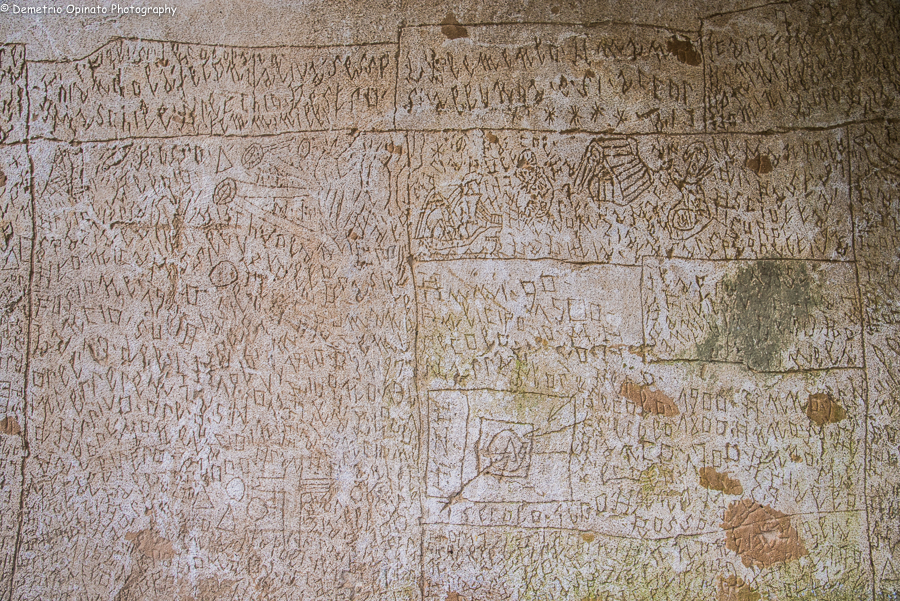
Sapevamo di quei graffiti, avevamo visto foto e letto decine di articoli in Internet su di loro ed in realtà l’ansia di incontrare quella storia ce l’avevamo addosso fin da quando avevamo messo piede in quel luogo.
NOF4, così spesso si firmava l’autore, rispondeva al nome di Oreste Fernando Nannetti, nato alla fine degli anni ’20 a Roma. Si pensa che il numero 4 che accompagna l’acronimo sia da riferirsi alla struttura in cui era stato internato o alla matricola con cui lo avevano registrato ma non esistono certezze al riguardo. In questo mondo Oreste Nannetti era solo e sempre lo era stato. Tuttavia nei suoi particolari racconti, NOF aveva dei fratelli e narrava di una simpatica tribù di uomini “spinacei“, termine con il quale spesso definiva buffamente anche la sua immagine, “alti e col naso ad Ipsylon“. Gli assomigliavano, erano la sua famiglia.
Cresciuto passando da un istituto a quello successivo, le quattro mura probabilmente non gli incutevano più alcun timore, ormai le conosceva bene. Ciò che forse lo terrorizzò davvero fu essere strappato alla sua adorata città. Idolatrava Roma ma la dovette salutare per sempre. Colpevole di oltraggio a pubblico ufficiale, il vizio totale di mente fu l’artefice della sua reclusione a Volterra, proprio nel padiglione Ferri. L’esilio, come per i più grandi poeti, fu la ferita peggiore che potessero infliggergli.
La sua voce la negò quasi a tutti. Ma al muro, caro vecchio amico, continuò a parlare e lo fece senza sconti.
Nei dieci anni di degenza al Ferri, con la sua scrittura bustrofedica, NOF incise 180 metri di graffiti (per circa, in media, due di altezza) sull’intonaco del perimetro della sua prigionia. La sua penna erano le fibbie degli indumenti facenti parte della divisa degli internati. Un altro ciclo di incisioni correva per 102 metri sul passamano in cemento di una scala. Erano lettere. Diari. Poesie. Aforismi. Figure geometriche. Disegni. Con la fredda lucidità di uno scienziato aveva voluto persino analizzare la mortalità ospedaliera: “il 10% – scriveva- muore per radiazioni magnetiche teletrasmesse; il 40% per malattie provocate o trasmesse; il 50% per odio o rancori personali provocati o trasmessi“. La rabbia uccide più di ogni altro mezzo, umano o inumano che sia e la sua trasmissione provoca la più feroce delle malattie.
Il mondo interiore di NOF non era uno specchio rassegnato della vita di Oreste Nannetti, sfuggiva ai suoi controllori in maniera beffarda, senza mai violare la loro sorveglianza. Il suo universo era fatto di viaggi galoppanti al di là delle conoscenze umane e di rivelazioni fantastiche. Di visioni privilegiate da “astronautico ingegnere minerario nel sistema mentale“. Si definiva un “colonnello astrale“.
Era “il Vagabondo delle stelle” di Jack London.
Ci incantiamo a guardare quei solchi cui è stata riconosciuta dignità d’arte.
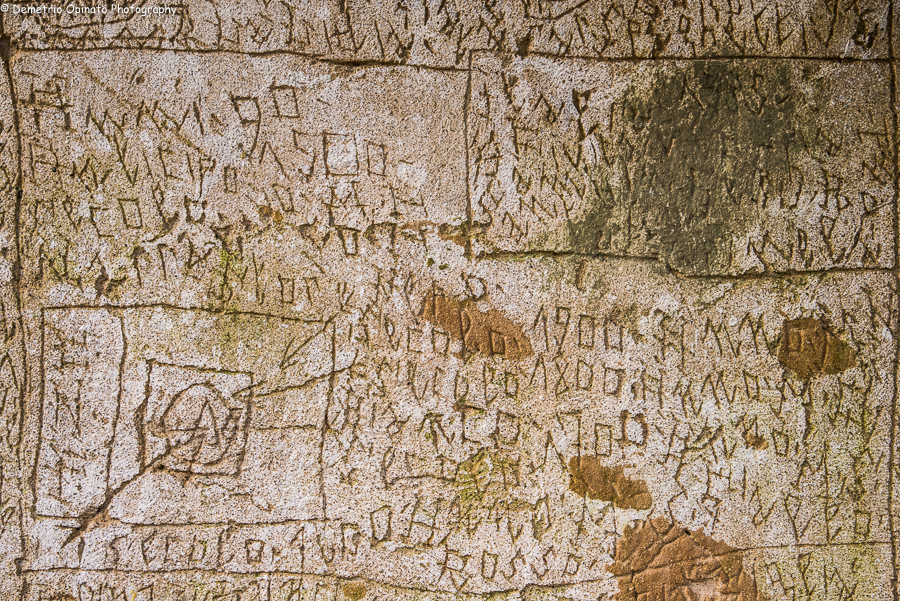
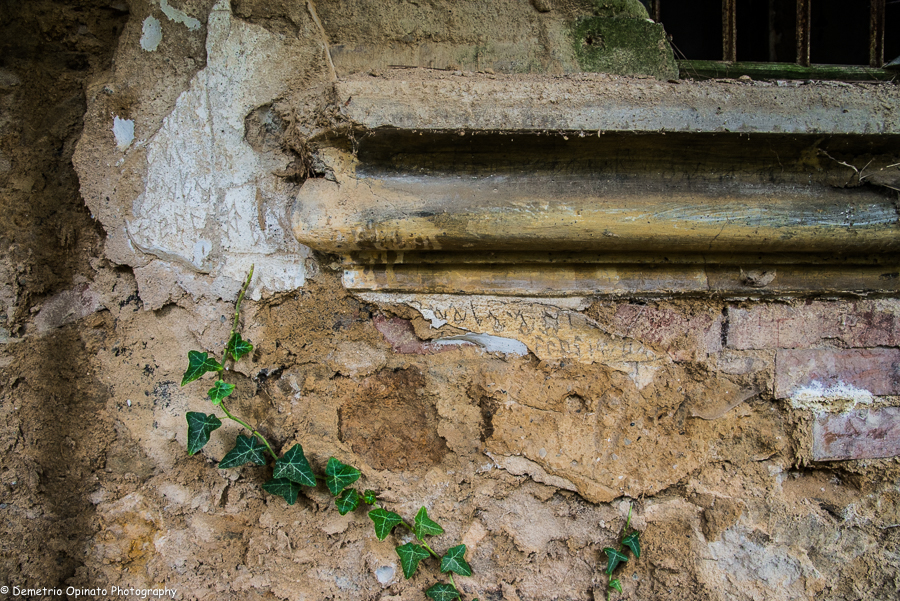
Lui non è qui e forse non c’è mai stato.
Tuttavia la sua testimonianza rimane in questo luogo a racchiudere ed evocare tutte le altre, che purtroppo possiamo solo immaginare. Gli scritti dei degenti, al termine della loro reclusione, venivano distrutti, come da protocollo. Quanti altri meravigliosi mondi fossero rinchiusi in questi posti o in altri simili, continueremo ad ignorarlo e forse quelle incisioni sono la più potente metafora di questa ignoranza.
Chi dovesse essere interessato, troverà numerosissimi estratti della straordinaria opera di NOF in giro per la rete. Nonostante i graffiti siano esposti al tempo ed ai suoi insulti (tranne che per un noto frammento, recuperato grazie all’intervento dell’associazione “Inclusione, Graffio e Parola” e conservato presso il museo dell’ex manicomio) sulla vita e gli scritti di Nannetti è stata appositamente realizzata una pubblicazione, a cura di Mino Trafeli, corredata dalle fotografie di Pier Nello Manoni: “NOF4, il libro della vita”.
Richiamo la vostra attenzione. Stiamo per lasciare questo posto. Il tempo è trascorso più rapido del previsto e la luce sta andando via. Tra non molto l’ex Ospedale sarà avvolto dalla sera e si rimetterà a dormire, visitatori permettendo.
Varcato il suo confine, percorriamo il viale con calma. L’aria è buona e la resina degli alberi ha un effetto sedante. Il silenzio è accondiscendente, ci lascia vagare con la mente e le impressioni.
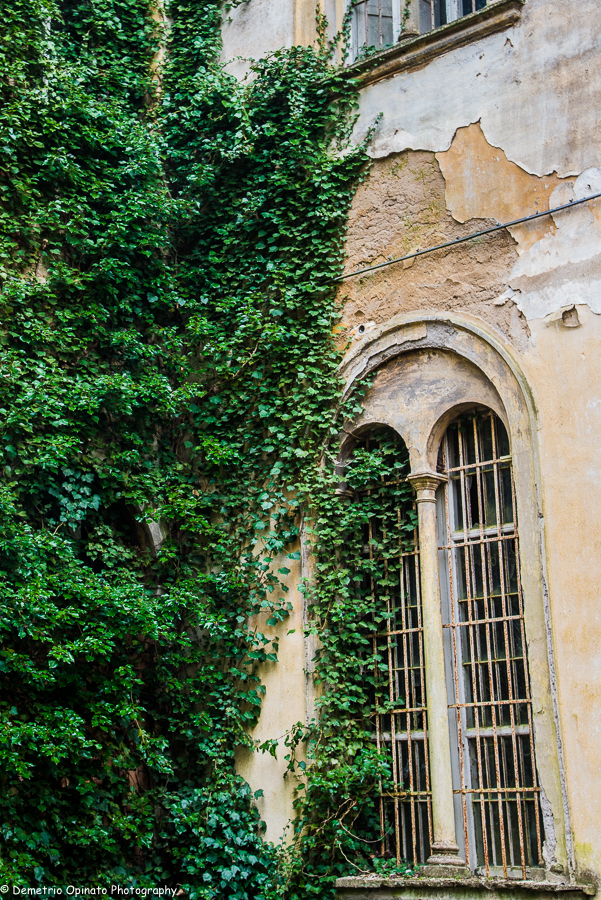
Risento in testa la canzone di qualche ora prima. Scusatemi ma quando sto bene o voglio stare bene, io accendo la radio.
Mi ricordo come continua, forse è il ritornello:
“We will be with you
When you’re leaving
We will be with you
When you go
We will be with you […]
you will stay with us.”
Rimarrai con noi, anche quando te ne sarai andato. Starai insieme a noi.
Mi torna in mente una delle più emozionanti frasi del colonnello:
“I fantasmi sono bellissimi, dalla loro seconda apparizione“.
Risaliamo in macchina, si va. È ora.
Si ringrazia l’associazione “Inclusione, Graffio e Parola” e il suo presidente Andrea Trafeli per le fonti e la gentile disponibilità.
English version below.
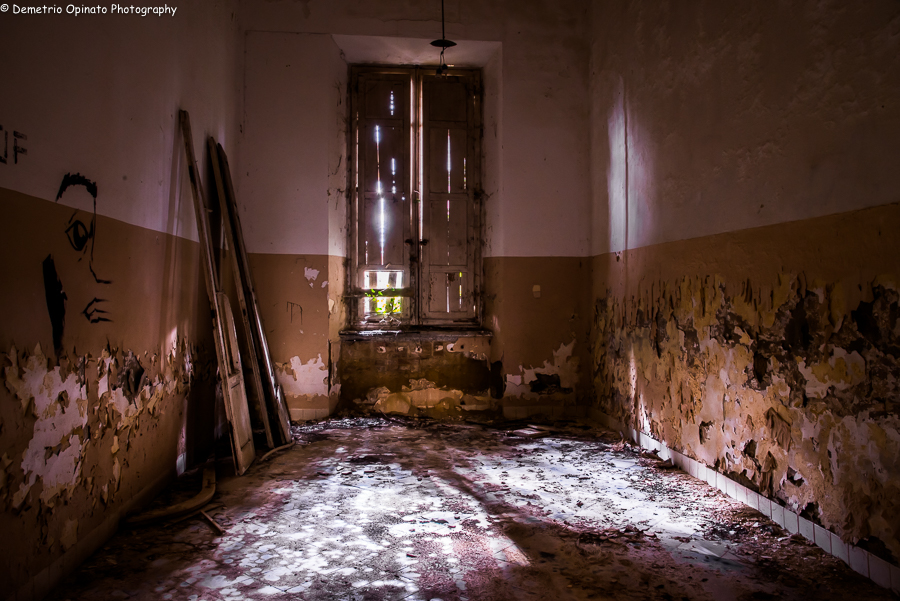
Voices engraved on stone
Former Psychiatric Hospital in Volterra – February 2017
(text by Sonia Caravelli – Pictures by Demetrio Massimo Opinato)
There is a little-known song by an eccentric Belgian artist that begin with these words: “since the day we found you / you have bene our friend / and your voice still echoes in the hallways of this house / but now / it’s the end”. The “voice” that “echoes in the corridors” has always caused me some thrill, I admit, but I love this piece. That afternoon, in our car, it wandered in my head for no apparent reason, while we were going to Volterra, a small town that counts about 10,000 souls in the county of Pisa, Tuscany. If you have never had the pleasure to visit it, you have to know that the old town is an invitation you can not ignore, the protagonist of dreamlike visions of famous directors and a proud banner of its Etruscan origins and of the extraordinary craftsmanship of the place. But this time it was not our direction. We wanted to reach the place that in a not too distant past had been a highlight of the town, amplifying its name throughout all Italy because of the grandeur of an ambitious project which soon became reality.
The old psychiatric Hospital of Volterra stems from a moral entity, born for the poor people, on June 5, 1884. It is said that it was Aurelio Caioli, the president of Volterra charity congregation, the first who sow the seeds of that future reality, stipulating agreements with the province of Pisa before and with neighboring ones later and healing, drop by drop, the patients transfert from the structures, scattered throughout the region, who had hosted them until then. Year after year the hospital area was expanding, with its old and new halls, accumulating land in the area of Borgo San Lazzero. It is estimated that around 1939, the entire structure counted nearly 5,000 patients.
Under the leadership of Luigi Scabia, the insane asylum director, the project experienced a flowering stage until becoming a real town. Scabia did not want any internee, but he wanted patients to treat and to give back to society. The verb “to cure” should powerfully draw the reader’s attention. For that times, wanting to cure madness was insane. Well, in Volterra they tried to do it. Far from becoming an idyll, the still strict hospital protocols, however, were marked by real therapy: the dignity, the more genuinely called “work.” Also if criticized for its possible utilitarian aspects, the occupational therapy of Scabia overthrew the geometry of care places, transforming the hospital in a village.
The frenocomio of San Girolamo was autonomous from all points of view, was equipped with a water line, a carpentry shop, a bakery, a shoemaking and many workshops. In 1933 it was even set up a currency for the exclusive use of the hospitalized workers for little purchases at the Hospital.
After Scabia, it seems that his directions were followed again for a respectable margin of time but the grip was coming and the place suffered a downward spiral that the sources record until 1963 or so. The change was inevitable, and the social transformation atmosphere began to pinch many noses. Deinstitutionalization was like a distant echo but it was heading towards opposite goals: the divestment.
The law n.180, in 1978, put an end to the long and, in most cases, extremely sad history of mental hospitals in Italy. Then the (complicated) reintegration of “sick people” in the “healthier world” had to begin. The structures of Borgo San Lazzero were finally abandoned in the early 80s. About a century had been passed.
And that’s where we are, immersed in the site of a long story, told in a few lines above (unpardonable as necessary synthesis). We walk slowly. There is a certain expectation with these kind of places, which sometimes remains disregarded. Here, instead, we meet a living material and the feeling is of being wrapped. The light is fantastic. Ok ok, the photographer could disagree, it is perhaps less fantastic while trying to capture an image properly. For sure, though, that gray, sad and delicate light could capture the thoughts perfectly. Sometimes, when we were inside the halls, going from room to room, it even smiled at us, making filter through the broken glass of the huge windows some unexpected ray of sunshine.
You have to bring respect for the past and when you go and visit him, you have to talk quietly. These are those strange things you do automatically and which, recovered a bit of clarity, hardly have an adequate justification.
The pavilions are scattered here and there, they show more or less the same structure inside: the living area on the ground where probably were the acceptance and patient registration offices, sleeping area above.
The upper floors are almost inaccessible, as indeed stairs. We are committed to find the items that really belong to those places and to separate them from the “intruders”: the black and white paving, still visible although rarely, cobble doors, a broken lamp with its two light bulbs, probably used to scan without misunderstandings the rhythms of the day. Bright light was used during day time, blue light for the night. Wheelchairs, perhaps not indigenous. Mannequins. Yes, you have not misread, there are a lot of mannequins. Almost all are without the head, someone is positioned near a window, someone is dropped on old empty bunks, one has even hung upside down. No, they have not shoot a noir movie here but the sets are everywhere. It seems that the great media love to give to the great public the great emotions that it expects. Disappoint him would be a great rip.
Go on.
We walk along a beautiful stone staircase, literally swallowed up by vegetation. Trees, “grown” hedges, each Mother Nature’s element seems to have had here an abnormal development. The twisted branches have recovered everything: roofs, windows, stone tables and other “appearance” furnishings. Everything is clinging by a powerful green embrace, sassy as sympathetic. I wonder what this place would be without it and the answer makes me immediately leave the question.
We arrive at the top. On the right there is the lonely pavilion “Ferri”. This is the judicial section, place of detention for criminals suffering from mental disorder. It is said that Scabia has been at all happy with this facility, posthumous introduced, ‘cause it was opposite to its treatment of social and human recovery. But apparently Scabia’s will was not decisive.
Here, too, the atmosphere is warm, the gray building is enlivened by the colors of the undisciplined nature that images explain more than words. Inside, the floor is a sea of debris, rubble and parts of an almost entirely collapsed ceiling. As elsewhere, the welcome is given by a long corridor on which innumerable rooms are opened, topped by windows that interrupt air with their heavy bars. Here too, hundreds and hundreds of murals by the protagonists of modern stories that have decided that those walls had to be their canvas. The written MADNESS screams from a wall. Granted? Maybe. Yet it manages to join the chorus perfectly.
More distant small penumbra rooms are defilate, lockouts, perhaps safer cells. You feel the need to air and light and we follow soon that need. Leaving the building, we continue to look around, even though we have already seen that yard. The building obviously has a different structure, it is surrounded by walls that do not permit to extend the view to the village. Those who came, moreover, altough they need terapy, were prisoners. That was a real containment structure. Naturally, we stop to observe those walls. It is obvious to think that they have much to tell. Yet you do not know how much. There they are.
We knew these graffiti, we had seen photos and read dozens of articles on the Internet about them and we were really anxious to meet that story.
NOF4, so often signed himself the author, was Oreste Fernando Nannetti, born in the late 20’s in Rome. It is thought that the number 4 which accompanies the acronym is to be referred to the structure where he had been interned or his registration number at the Hospital but there are no certainties in this regard. In his life, Oreste Nannetti was alone and always had been. However in his stories, NOF had brothers and told of a friendly tribe of “spinacei” men, a term which he often use also to describe his image, “tall and with an Y nose“. They looked like him, they were his family.
Grew up moving from one institution to the next, the “four walls” probably did not cause him any fear, he knew them very well. Perhaps what really terrified him was being ripped to his beloved city. He idolized Rome but had to say her goodbye. He never came back. Guilty of insulting a public official, the mental disorder was the architect of his imprisonment in Volterra, right in the pavilion Ferri. The exile, like for the greatest poets, was the worst injury that society could inflict him.
He denied his voice to almost everyone. But with the wall, dear old friend, he kept talking and he did it without discounts.
In ten years of recovery at Ferri, with its boustrophedon writing, NOF engraved 180 meters of graffiti (high, on average, two meters) on the perimeter wall of his imprisonment. His pen was the buckles of clothing of the internees uniform. Another cycle of engravings ran for 102 meters on the handrail of a cement railings. There were letters. Diaries. Poems. Aphorisms. Geometric figures. Drawings. With the cold clarity of a scientist he had even analyzed the mortality of the place: “10% of patients- he writed- dies from magnetic radiation; 40% from caused or transmitted diseases; 50% from personal hatred or rancor caused or transmitted.” Anger kills more than any other, human or inhuman, and its transmission causes the fiercest of diseases.
NOF inner world was not a resigned mirror of Oreste Nannetti life, he escaped to his controllers in a mocking, without violating their surveillance. His universe was made of galloping travels beyond human knowledge and fantastic revelations. It was made of privileged visions as “Astronaut mining engineer of the mental system“. He defined himself an “astral Colonel“.
He was “the Star Rover” by Jack London.
We enchanted ourself looking at that engravings which has been considered as art.
NOF is not here, and maybe there never was.
However his testimony remains in this place to enclose and evoke all the others, which unfortunately we can only imagine. The writings of the patients, at the end of their time, were destroyed, as protocol wanted. How many other wonderful worlds were locked up in these places or similar ones, we will continue to ignore and maybe those incisions are the most powerful metaphor for this ignorance.
If anyone was interested, he could simply find numerous extracts of the extraordinary work of NOF on the Internet. Despite the graffiti are exposed to the weather and to his insults (except for a known fragment, recovered thanks to the association “Inclusione, graffio e parola” and kept in the hospital museum) on the life and writings of Nannetti has been specifically designed a publication, edited by Mino Trafeli, accompanied by photographs of Pier Nello Manoni: “NOF4, the book of life”.
I have to claim your attention now. We’re going to leave this place. Time is passed faster than expected and the light is going away. In few minutes the hospital will be enveloped by the evening and will recover to sleep, if visitors permit it.
Crossed its border, we walk the avenue calmly. The air is good and tree resin has a sedative effect. Silence is condescending, allowing us to roam with the mind and the impressions.
I remember another piece of that song in my head. Excuse me, but when I’m good or I want to feel good, I turn on the radio.
I remember maybe the chorus:
“We will be with you
When you’re leaving
We will be with you When you go
We will be with you […]
you will stay with us. “
You will remain with us, even when you’re gone.
I think about one of the most exciting Colonel’s sentences:
“Ghosts are beautiful, at their second appearance.“
Back into the car, we go. It’s the time.
We thank the association “Inclusione, graffio e parola” and its president Andrea Trafeli for sources and for the kind availability.